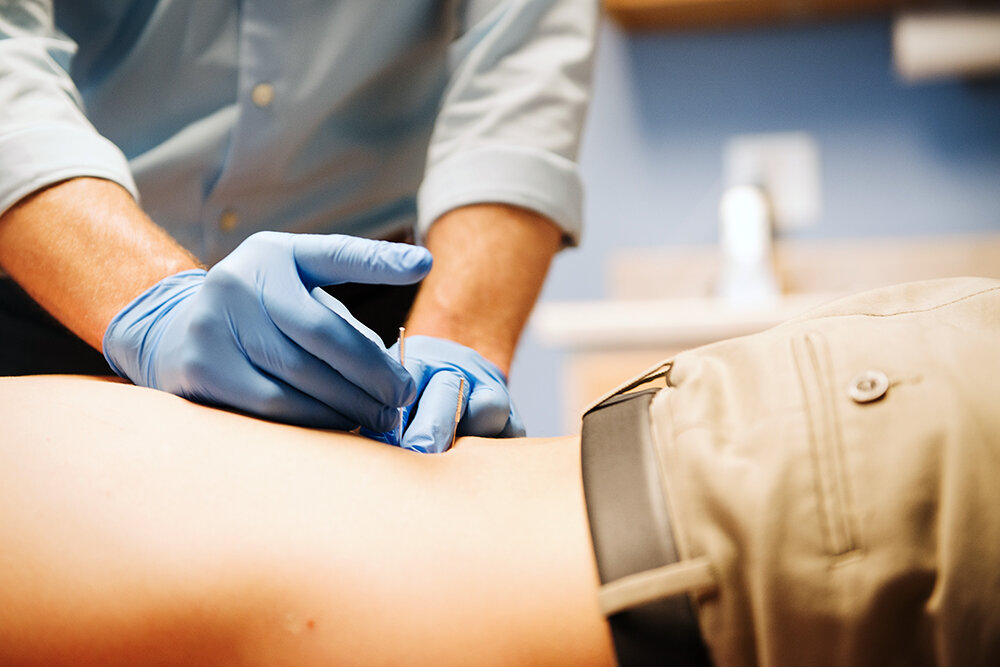Dry Needling
Dry needling is a technique where a physical therapist uses a "dry" needle (one that does not contain medication or syringe for medication) inserted through the skin into areas of the muscle. The dry needle is placed into various myofascial trigger points (painful knots in muscles), tendons, ligaments, or nerves in order to stimulate a healing response in musculoskeletal conditions. Although the practice may look similar to acupuncture, a practice based on traditional Chinese medicine and performed by acupuncturists, dry needling is actually a part of modern Western medicine principles and supported by research.
Our Physical Therapy and Sports Medicine Departments offer dry needling for painful musculoskeletal conditions and sports-related injuries. We also offer dry needling as a direct-access service to patients and offer same-day and same week appointments for this technique.
Our Physical Therapy Team
Simon Hoehn, PT, DPT
Director of Physical Therapy
Monica Rosa, PT
Bilingual Physical Therapist
Adam Fletcher, PT, DPT
Physical Therapist
Penny Jones, PT
PT & EMG/NVC Testing
Jesse Edward, PTA
Physical Therapy Assistant
Jessica Piercy, PT, DPT
Women’s Health P.T.
Thomas Hinkebein, PT, DPT
Sports & Performance PT
Rachel Forrester, PT, DPT
Physical Therapist
Aurelio Puga, LAT, ATC
Director of Athletic Training
Marcus Mager, PTA
Physical Therapy Assistant
Jared Simpson, PT, DPT
Physical Therapist
Helen Jiang, PT, DPT
Physical Therapist
Lutoria Herbert, PT, DPT
Physical Therapist
Katie Germak, PTA
Physical Therapy Assistant
Ann Mills, PTA
Physical Therapy Assistant
Conditions Treated
Dry needling is not typically utilized as a stand alone treatment procedure. Instead, dry needling is utilized as part of an overall physical therapy plan that will likely include other passive and active treatment modalities. Most commonly, dry needling is used to increase range of motion that may be limited due to muscle tightness or scar tissue.
Additionally, dry needling is commonly used to treat the following conditions:
Acute and chronic pain
Muscle pain and tightness
Muscle knots
Joint pain
Tendinitis (Tennis/Golfer’s Elbow)
Migraines and tension-type headaches
Neck and back pain
Phantom pain
Restricted range of motion in joints
Shoulder pain
Knee pain
Hip pain
Heel pain
Plantar fasciitis
Sciatica
Carpal tunnel syndrome
Why Try Dry Needling?
Physical therapists use dry needling to release or inactivate trigger points to relieve pain or improve range of motion in affected joints. Current research supports the finding that dry needling improves pain control, reduces muscle tension, and normalizes dysfunctions of the motor end plates (the sites at which nerve impulses are transmitted to muscles). This process has been found to accelerate a patient's return to active rehabilitation.
At Aptiva Health, our physical therapists who perform dry needling have advanced training and certifications to ensure proper technique is utilized to maximize patient recovery.
Does Dry Needling Hurt?
Dry needling therapy uses a very thin solid needle or filament to disrupt the trigger point, or muscle knot, and elicit a “twitch response” which returns that muscle to a normal state by allowing inflammatory chemicals to leave the trigger point, relax the muscle and restore blood flow to the area. While dry needling does penetrate the muscles, the needles are very thin and you may or may not feel the insertion of the needle. Some patients may feel a brief ache or cramping sensation during the twitch response.




















